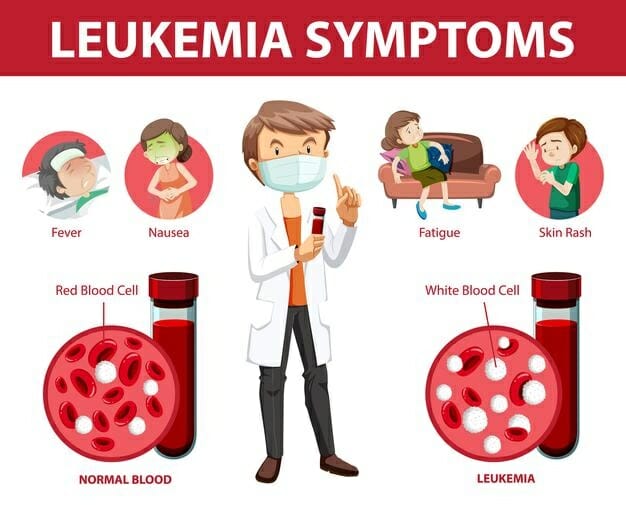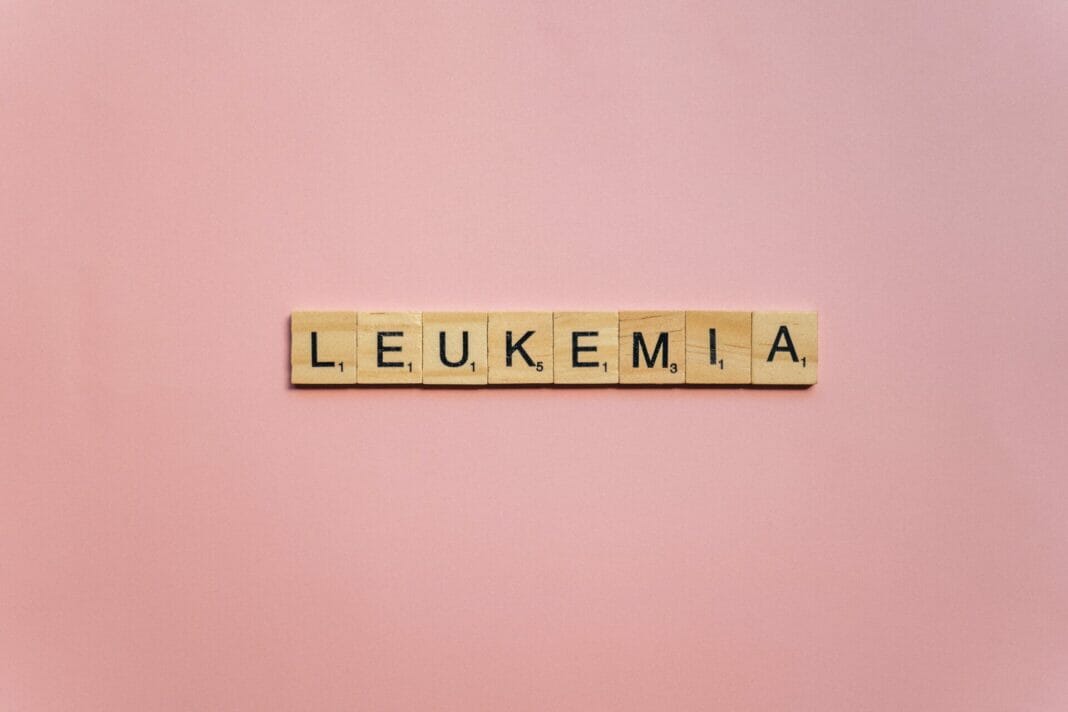Leukemia is a type of cancer that affects developing blood cells, it affects the body’s blood forming tissues, the bone marrow and the lymphatic system. Inside the people living with leukemia, abnormal white blood cells are being produced, thereby affecting the body’s ability to produce healthy new blood cells and effectively respond to infections. There are several symptoms of leukemia in adults.
There are several types of leukemia and they can be grouped in several different ways. Some forms of leukemia are more common in children while other forms of leukemia occur mostly in adults.
The different types of leukemia can include how quickly it progresses (acute versus chronic), and what type of cells are affected (lymphocytic versus myeloid).
Leukemia usually involves white blood cells. The white blood cells are infection fighters, normally, they grow and divide in an orderly way, as your body needs them. But in people living with leukemia, the bone marrow produces an excessive amount of abnormal white blood cells, which cannot function properly.
Common symptoms of leukemia in adults can be very similar to other illnesses and they include things like fatigue and fever. Because of this, leukemia can sometimes be difficult to diagnose.
Continue reading as we break down the various symptoms of leukemia in adults.
Types Of Leukemia
The major types of leukemia are:
- Acute lymphocytic leukemia (ALL). This is the most common type of leukemia in young children. ALL can also occur in adults.
- Acute myelogenous leukemia (AML). AML is a common type of leukemia. It occurs in children and adults. AML is the most common type of acute leukemia in adults.
- Chronic lymphocytic leukemia (CLL). With CLL, the most common chronic adult leukemia, you may feel well for years without needing treatment.
- Chronic myelogenous leukemia (CML). This type of leukemia mainly affects adults. A person with CML may have few or no symptoms for months or years before entering a phase in which the leukemia cells grow more quickly.
- Other types. Other, rarer types of leukemia exist, including hairy cell leukemia, myelodysplastic syndromes and myeloproliferative disorders.

Symptoms Of Leukemia In Adults
Leukemia symptoms are different, depending on the type of leukemia. Some of the most common symptoms of leukemia in adults prior to diagnosis include:
- Sweating at night excessively
- Fever
- Frequent fatigue and weakness
- Frequent or severe infections
- Swollen lymph nodes, enlarged liver or spleen
- Bruising and bleeding easily
- Recurrent nosebleeds
- Tiny red spots in your skin (petechiae)
- Excess weight loss
- Bone and joints pain or tenderness
Other symptoms of Leukemia that an adult may experience are:
- Enlarged liver or spleen
- Headaches
- Loss of appetite
- Abdominal discomfort
- Pale skin
- Feeling dizzy
- Swollen lymph nodes
- Nausea or vomiting
- Numbness

Leukemia In Adults 18 – 24yrs
Acute lymphocytic leukemia (ALL) is the most common type of leukemia in children and young adults. According to the American Cancer Society, the risk of Acute lymphocytic leukemia (ALL) is highest when a child is under age 5 and it slowly declines until the mid 20s.
When it comes to Acute lymphocytic leukemia, the bone marrow makes too many white blood cells, called lymphocytes. While healthy lymphocytes are important for responding to infections, the abnormal ones don’t function as effectively.
Increasing numbers of abnormal lymphocytes also mean that healthy blood cells get crowded out. Acute lymphocytic leukemia is a type of leukemia that can quickly worsen if not detected and treated.
Some common signs of Acute lymphocytic leukemia in young adults are:
- Headaches
- Fatigue or weakness
- Easy bruising or bleeding
- Shortness of breath
- Fever or night sweats
- Aching in bones or joints
Read Also: 12 Healthy Habits Your Body Needs
Leukemia In Adults 25 – 49yrs
Acute myeloid leukemia (AML) is the most common type of leukemia in adults between ages 25 – 49. However, the American Cancer Society noticed that it is still generally uncommon before age 45.
When it comes to Acute myeloid leukemia (AML), the bone marrow makes too much immature type of blood cell called a myeloblast. These myeloblasts do not develop into healthy blood cells.
The effects of Acute myeloid leukemia can affect the production of healthy blood cells, which can include red blood cells and platelets. The increasing numbers of myeloblasts can also begin to crowd out healthy blood cells. Acute myeloid leukemia can rapidly progress without treatment just like Acute lymphocytic leukemia.
Some common signs of Acute myeloid leukemia in adults are:
- Frequent infections
- Feelings of fatigue or weakness
- Easy bruising or bleeding
- Shortness of breath
- Fever or night sweats
- Aching in bones or joints
Leukemia In Adults 50 – 64yrs
Acute myeloid leukemia is also common in this age group. Additionally, another type of leukemia that can be common in this age group is chronic lymphocytic leukemia (CLL).
Chronic lymphocytic leukemia (CLL) is similar to Acute lymphocytic leukemia (ALL) because the bone marrow produces too many abnormal lymphocytes. However, chronic lymphocytic leukemia (CLL) progresses more slowly. Because of this, many people with Chronic lymphocytic leukemia (CLL) won’t experience significant symptoms at the time of their diagnosis.
Some common signs of Acute myeloid leukemia (AML) or chronic lymphocytic leukemia (CLL) in adults between the age of 50 to 64 are:
- Feelings of fatigue or weakness
- Easy bruising or bleeding
- Shortness of breath
- Fever or night sweats
- Aching in bones or joints
- Frequent infections
Leukemia In Adults Ages 65 And Older
chronic lymphocytic leukemia (CLL) is also one of the most common types of leukemia in adults ages 65 and older. In fact, according to the American Cancer Society, the average age of chronic lymphocytic leukemia (CLL) diagnosis is 70 years old.
Another type of leukemia that may be seen in this age group is chronic myeloid leukemia (CML). While the average age of diagnosis is 64, the American Cancer Society notes that almost half of cases are diagnosed in individuals ages 65 and older.
When it comes to chronic myeloid leukemia (CML), too many developing blood cells become a type of cell called a granulocyte. Similar to the other types of leukemia we have talked about, these abnormal granulocytes can crowd out healthy blood cells.
Like chronic lymphocytic leukemia (CLL), chronic myeloid leukemia (CML) progresses slowly. It’s possible that people with chronic myeloid leukemia (CML) may have no symptoms or only vague, nonspecific symptoms at the time of diagnosis.
Some common signs of leukemia in adults ages 65 and older are:
- Unexplained weight loss
- Swollen lymph nodes
- Feelings of fatigue or weakness
- Easy bruising or bleeding
- Shortness of breath
- Fever or night sweats
Symptoms Of Leukemia That Women Should Take Note Of.
In addition to the symptoms that we have talked about above, there are certain symptoms of leukemia for women to be aware of. If leukemia is a concern, it’s important that any of these symptoms be evaluated by a health professional. Because leukemia can affect platelet production, people with leukemia can bleed more easily. Women with leukemia may find that they experience:
- heavier menstrual periods than usual
- significant spotting between periods
Additionally, it’s important to note that some leukemia symptoms can be similar to those of menopause. These can include things like:
- night sweats
- hot flashes
- fatigue
Pregnancy can also mask some of the potential symptoms of leukemia. For example, fatigue is very common during pregnancy but can also sometimes be a possible sign of leukemia.
Risk Factors For Developing Leukemia As An Adult
There are numerous risk factors that are linked to developing leukemia. These can include:
- Gender: Males are more likely to develop leukemia than females.
- Age: With the exception of Acute lymphocytic leukemia (ALL), the risk of getting other types of leukemia increases as a person gets older.
- Family history: Having a close family member, such as a parent or sibling, with leukemia can increase a person’s risk.
- Previous cancer treatment: It’s possible that people who’ve had chemotherapy or radiation therapy for another type of cancer can be at an increased risk of developing leukemia.
- Smoking: Smoking cigarettes can be a risk factor for developing Acute myeloid leukemia (AML). Environmental exposures. Exposure to radiation or industrial chemicals like benzene raise a person’s risk of leukemia.
- Certain blood disorders: Certain types of blood disorders, such as myelodysplastic syndromes, can raise your risk of getting leukemia.
- Some genetic disorders: Having some types of genetic disorders, such as Down syndrome or Fanconi syndrome, can increase the risk of leukemia.
When To See A Doctor
The symptoms of leukemia can be similar to those of other more common health conditions. Because of this, it can sometimes be difficult to know when to schedule a medical appointment.
Generally speaking, it’s a good idea to talk to a healthcare professional if you notice concerning symptoms that could indicate leukemia, particularly if you have any of the risk factors listed above.
Here are some signs that it could be time to schedule a medical appointment:
- Persistent symptoms: Some symptoms of leukemia can be persistent, meaning that they don’t really go away or recur frequently. Some examples include fatigue, shortness of breath, and infections.
- Unexplained symptoms: Several leukemia symptoms can happen without an obvious cause or explanation. Examples include things like fever, night sweats, and unintended weight loss.
- New changes: It’s possible that leukemia can cause new, noticeable changes in a person’s body. Examples include easy bruising, heavier periods in women, or swollen lymph nodes.
A health professional can perform a physical examination and blood tests to help get an idea of what may be causing your symptoms. If leukemia is suspected, they’ll order additional tests such as a bone marrow biopsy.
Causes Of Leukemia
Scientists don’t understand the exact causes of leukemia. It seems to develop from a combination of both genetic and environmental factors.
Read Also: 25 Effective Ways To Be Healthier In 2022 And Beyond
Conclusion
There are different types of leukemia. Most of them are more common in older adults than they are in younger individuals. However, some types of leukemia, such as ALL, are more common in children and young adults.
Many of the symptoms of leukemia in adults are similar to other health conditions, like fatigue, fever, and shortness of breath. It’s also possible that symptoms can vary based on the type of leukemia or your age.
Talk with a healthcare professional if you have symptoms that are consistent with leukemia, especially if they’re persistent or can’t be explained by another condition. Specific tests can be done to find out what may be causing them.



